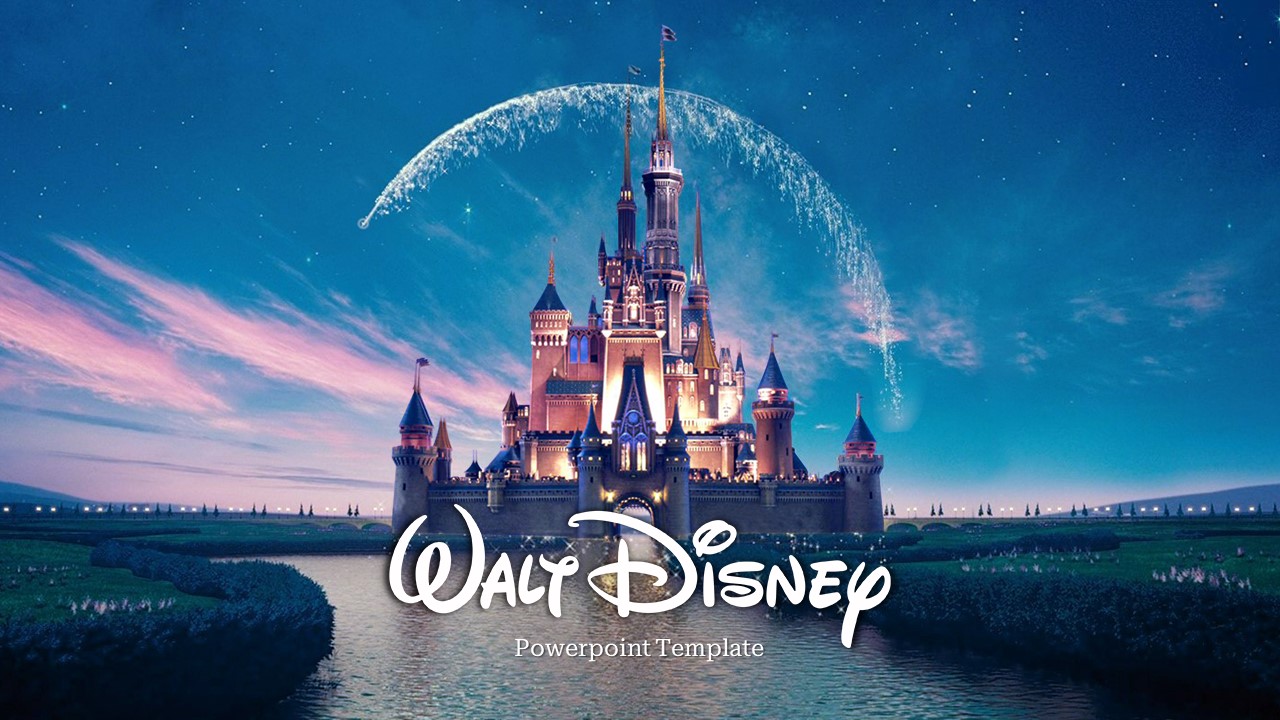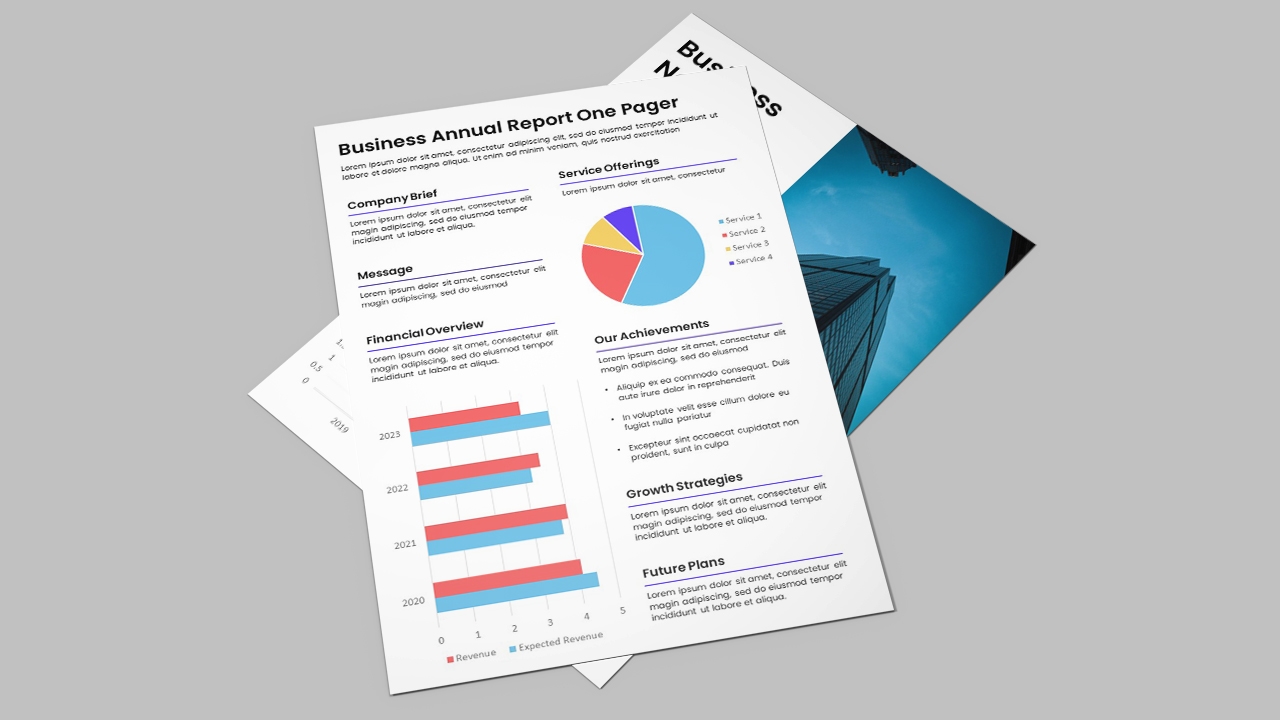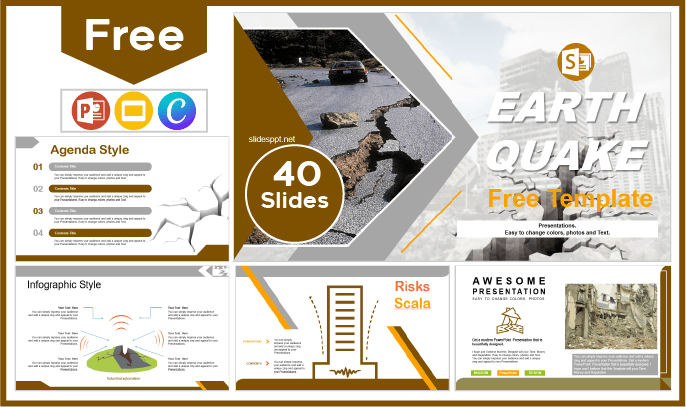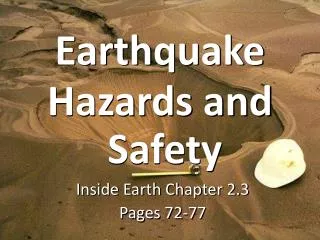Types of Stress
The stress force called tension pulls on the crust, stretching rock so that it becomes thinner in the middle.
- Forces in Earth’s Crust
Earthquakes
The stress force called compression squeezes rock until it folds or breaks.
Stress that pushes a mass of rock in two opposite directions is called shearing .
Kinds of Faults
Tension in Earth’s crust pulls rock apart, causing normal faults.
A reverse fault has the same structure as a normal fault, but the blocks move in the opposite direction.
In a strike-slip fault, the rocks on either side of the fault slip past each other sideways, with little up and down motion.
Changing Earth’s Surface
Over millions of years, the forces of plate movement can change a flat plain into landforms such as anticlines and synclines, folded mountains, fault-block mountains, and plateaus.
Building Vocabulary
A definition states the meaning of a word or phrase. As you read, write a definition of each Key Term in your own words.
Stress is a force that acts on rock to change its shape or volume.
compression
normal fault
Tension in Earth’s crust pulls rock apart, causing normal faults .
reverse fault
hanging wall
strike-slip fault
The block of rock that lies above a normal fault is called the hanging wall .
The rock that lies below is called the footwall .
In a strike-slip fault , the rocks on either side of the fault slip past each other sideways, with little up or down motion.
A fold in rock that bends upward into an arch is an anticline .
A fold in rock that bends downward to form a valley is a syncline .
A plateau is a large area of flat land elevated high above sea level.
End of Section:�Forces in Earth’s Crust
Types of Seismic Waves
Seismic waves carry energy from an earthquake away from the focus, through Earth’s interior, and across the surface.
- Earthquakes and Seismic Waves
P waves are seismic waves that compress and expand the ground like an accordion. S waves are seismic waves that vibrate from side to side as well as up and down.
Surface waves move more slowly than P waves and S waves, but they produce the most severe ground movements.
Seismic Waves Activity
Click the Active Art button to open a browser window and access Active Art about seismic waves.
Measuring Earthquakes
The Mercalli scale was developed to rate earthquakes according to the amount of damage at a given place.
Locating the Epicenter
Geologists use seismic waves to locate an earthquake’s epicenter.
Identifying Main Ideas
As you read the section “Types of Seismic Waves,” write the main idea in a graphic organizer like the one below. Then write three supporting details. The supporting details further explain the main idea.
Seismic waves carry the energy of an earthquake.
P waves compress and expand the ground.
S waves vibrate from side to side as well as up and down.
Surface waves produce the most severe ground movements.
End of Section:�Earthquakes and Seismic Waves
The Modern Seismograph
Seismic waves cause the seismograph’s drum to vibrate. But the suspended weight with the pen attached moves very little. Therefore, the pen stays in place and records the drum’s vibrations.
- Monitoring Earthquakes
Instruments That Monitor Faults
In trying to predict earthquakes, geologists have developed instruments to measure changes in elevation, tilting of the land surface, and ground movements along faults.
Using Seismographic Data
The map shows the probability of a strong earthquake along the San Andreas fault. A high percent probability means that a quake is more likely to occur.
As you read, make a flowchart like the one below that shows how a seismograph produces a seismogram. Write each step of the process in a separate box in the order in which it occurs.
How a Seismograph Works
Incoming seismic waves
Vibrate the rotating drum
The suspended pen remains motionless and records the drum’s vibration.
End of Section:�Monitoring Earthquakes
Earthquake Risk
Geologists can determine earthquake risk by locating where faults are active and where past earthquakes have occurred.
- Earthquake Safety
How Earthquakes Cause Damage
A tsunami spreads out from an earthquake's epicenter and speeds across the ocean.
Designing Safer Buildings
To reduce earthquake damage, new buildings must be made stronger and more flexible.
Asking Questions
Before you read, preview the red headings and ask a what , how , or where question for each heading. As you read, write answers to your questions.
Where is the quake risk highest?
Earthquake risk is the highest along faults and where past earthquakes have occurred.
How do earthquakes cause damage?
Earthquake damage occurs as a result of shaking, liquefaction, aftershocks, and tsunamis.
How can you stay safe during an earthquake?
The best way to stay safe during an earthquake is to drop, cover, and hold.
What makes buildings safe from earthquakes?
Buildings can be made safer by being built stronger and with greater flexibility.
End of Section:�Earthquake Safety
Graphic Organizer
Strike-slip
End of Section:�Graphic Organizer
Home / Free Creative Google Slides & PowerPoint Templates / Free Earthquake PowerPoint Presentation theme & Google Slides

Free Earthquake PowerPoint Presentation theme & Google Slides

About the Template
Free earthquake presentation theme.
Download our free earthquake presentation templat e, a vital tool that goes beyond slides aiming to save lives. On an average, earthquake of magnitude 8, takes around 10000 deaths annually. Collapsing buildings, roads, taking lives. The destruction is often compounded by floods, tsunami.
In today’s situation understanding earthquake dynamics is crucial and our disaster template stands as a beacon of comprehensive knowledge and impactful presentation.
As earthquakes pose a serious threat, waiting until it’s too late is not an option. Take charge now – empower your audience with the knowledge they need to stay safe in potentially dangerous situations. Don’t just present; revolutionize your approach to seismic education.
Download our Free Earthquake Template and redefine the way you communicate vital information. Because when it comes to earthquakes, awareness is the key, and our template unlocks a new level of understanding.
Google Slide,PowerPoint
100% Fully Customizable
Free to use
Slides From Powerpoint
Free Active Template Library
Free Google Slides Templates
Free Slidemodel Templates
Slideshow Model Templates
Natural Disasters

Free Walt Disney PowerPoint and Google Slides Templates

Free In Loving Memory of Template PowerPoint & Google Slides

Free Sneakers Launch Deck Template PowerPoint & Google Slides

Free Google Slides Vintage Theme PowerPoint Template

Free Business One Pager PowerPoint Template & Google Slides
Are you looking for custom presentation template designs.
It is a long established fact that a reader will be distracted by the readable content of a page when or randomised words which don’t look even slightly believable
Pete’s PowerPoint Station
- Science Index
- Math/Maths Index
- Language Arts/Literature Index
- Social Studies Index
- Holidays Index
- Art, Music, and Many More, A-Z
- Meteorology
- Four Seasons
- Pre-Algebra
- Trigonometry
- Pre-Calculus & Calculus
- Language Arts
- Punctuation
- Social Studies
- World Religions
- US Government
- Criminal Justice
- Famous People
- American History
- World History
- Ancient History
- The Middle Ages
- Architecture
- All Topics, A–Z
- Privacy & Cookie Policy
- Presentations
Earthquakes
Free Presentations in PowerPoint format
Understanding Earthquakes
Earthquakes and Faults
Earthquakes – Understanding Geology
Earthquakes – Preventing Disasters in Japan
Earthquakes – How Often Do They Occur?
Earthquakes and Building Safety
Earthquakes – What Causes Them?
Earthquakes and volcanoes
Earthquakes and Architecture
Earthquake Waves (salem)
See Also: Plate Tectonics , Ocean Motion , Natural Hazards
Free Online Earthquake GAMES & Kids Sites
Free Flash Presentations
For Teachers
Lots of Lessons – Earthquakes
Free Video Clips/Mini Movies
Free Online Science Games for Kids
Free Clipart for Science

- Earthquake Template
An earthquake, also known as an earthquake or tremor, is a natural geological phenomenon that occurs when accumulated stresses in the Earth's crust are suddenly released. This causes the propagation of seismic waves through the Earth, generating oscillatory movements on the surface that can vary in intensity from slight vibrations to violent shaking. Today you can take advantage of the custom designed earthquake template to create your own disaster presentations like an expert on the subject.
Our earthquake template for PowerPoint and Google Slides includes amazing images, animations and backgrounds that reflect the destructive power of this natural disaster. On the other hand, it has 40 slides that can be customized from any program on your pc or through an online platform such as Canva. The most surprising thing is that this presentation includes statistical graphs and timelines that specify this type of facts. In short, downloading this free ppt resource is a must for you if you are looking to talk about this type of incident.
Free Earthquake Template for PowerPoint and Google Slides

Main features
- 40 slides 100% editable
- 16:9 widescreen format suitable for all screens
- High quality royalty-free images
- Easy to edit layouts for presenting or printing
- Included resources: charts, graphs, timelines and diagrams
- More than 100 icons customizable in color and size
- Main font: TT Norms Bold
- Predominant color: Brown
Download this template
Are you looking to talk about this kind of topics, but you don't know how to prepare a presentation? Well, the solution is in our repertoire of Google Slides themes and natural disasters PowerPoint templates. Here you will find ready-made ppt designs so that you only have to enter your information and get ready to give your presentation.
We use cookies to improve the experience of everyone who browses our website. Cookies Policy
Accept Cookies
Got any suggestions?
We want to hear from you! Send us a message and help improve Slidesgo
Top searches
Trending searches

15 templates

26 templates

49 templates

american history
76 templates


great barrier reef
17 templates

39 templates
Plate Tectonics and Earthquakes - Earth Sciences - 10th Grade
It seems that you like this template, plate tectonics and earthquakes - earth sciences - 10th grade presentation, free google slides theme, powerpoint template, and canva presentation template.
Our planet is constantly changing, and nowhere is this more evident than in the study of plate tectonics and earthquakes. "Wait, did you say 'plate tectonics'? Isn't it 'tectonic plates'?" Almost! Plate tectonics is a theory that states that Earth's litosphere has been in constant movement for billions of years via the tectonic plates, hence the confusion! This template has arrived to help you "shake up" the world of education. Customize the slides, the diagrams, the exercises, the graphs, the text boxes, everything included to start teaching in a successful way.
Features of this template
- 100% editable and easy to modify
- 35 different slides to impress your audience
- Contains easy-to-edit graphics such as graphs, maps, tables, timelines and mockups
- Includes 500+ icons and Flaticon’s extension for customizing your slides
- Designed to be used in Google Slides, Canva, and Microsoft PowerPoint
- 16:9 widescreen format suitable for all types of screens
- Includes information about fonts, colors, and credits of the resources used
How can I use the template?
Am I free to use the templates?
How to attribute?
Attribution required If you are a free user, you must attribute Slidesgo by keeping the slide where the credits appear. How to attribute?
Related posts on our blog.

How to Add, Duplicate, Move, Delete or Hide Slides in Google Slides

How to Change Layouts in PowerPoint

How to Change the Slide Size in Google Slides
Related presentations.

Premium template
Unlock this template and gain unlimited access

Register for free and start editing online
- Preferences

Earthquake PowerPoint PPT Presentations


Apr 02, 2019
490 likes | 1.13k Views
Earthquake. Earthquake. An earthquake (also known as a quake , tremor or temblor ) is the result of a sudden release of energy in the Earth's crust that creates seismic waves .
Share Presentation
- magnitude earthquake
- smart class co
- active plate boundary
- general thimayya public school
- nuclear tests

Presentation Transcript
Earthquake • An earthquake (also known as a quake, tremor or temblor) is the result of a sudden release of energy in the Earth'scrust that creates seismic waves. • The seismicity, seismism or seismic activity of an area refers to the frequency, type and size of earthquakes experienced over a period of time.
Earthquakes are measured using observations from seismometers. • The moment magnitude is the most common scale on which earthquakes larger than approximately 5 are reported for the entire globe. • The more numerous earthquakes smaller than magnitude 5 reported by national seismological observatories are measured mostly on the local magnitude scale, also referred to as the Richter scale. • These two scales are numerically similar over their range of validity.
Magnitude 3 or lower earthquakes are mostly almost imperceptible or weak and magnitude 7 and over potentially cause serious damage over larger areas, depending on their depth. • The largest earthquakes in historic times have been of magnitude slightly over 9, although there is no limit to the possible magnitude.
The most recent large earthquake of magnitude 9.0 or larger was a 9.0 magnitude earthquake in Japan in 2011 (as of October 2012), and it was the largest Japanese earthquake since records began. • Intensity of shaking is measured on the modified Mercalli scale. • The shallower an earthquake, the more damage to structures it causes, all else being equal.
At the Earth's surface, earthquakes manifest themselves by shaking and sometimes displacement of the ground. • When the epicenter of a large earthquake is located offshore, the seabed may be displaced sufficiently to cause a tsunami. • Earthquakes can also trigger landslides, and occasionally volcanic activity.
In its most general sense, the word earthquake is used to describe any seismic event — whether natural or caused by humans — that generates seismic waves. • Earthquakes are caused mostly by rupture of geological faults, but also by other events such as volcanic activity, landslides, mine blasts, and nuclear tests. • An earthquake's point of initial rupture is called its focus or hypocenter. The epicenter is the point at ground level directly above the hypocenter.
History • The ancient Chinese also used a device that looked like a jar with dragons on the top surrounded by frogs with their mouths open. • When an earthquake occurred, a ball fitted into each dragon's mouth would drop out of the dragon's mouth into the frog's. The position of the frog which received a ball indicated the direction of the earthquake.
Causes of earthquakes • Earthquakes are caused by tectonic movements in the Earth's crust. • The main cause is that when tectonic plates collide, one rides over the other, causing orogeny (mountain building), earthquakes and volcanoes.
The boundaries between moving plates form the largest fault surfaces on Earth. • When they stick, relative motion between the plates leads to increasing stress. • This continues until the stress rises and breaks, suddenly allowing sliding over the locked portion of the fault, releasing the stored energy.
Earthquake clusters • Most earthquakes form part of a sequence, related to each other in terms of location and time. • Most earthquake clusters consist of small tremors which cause little to no damage, but there is a theory that earthquakes can recur in a regular pattern.
Earthquake fault types • There are three main types of fault that may cause an earthquake: normal, reverse (thrust) and strike-slip. • Normal faults occur mainly in areas where the crust is being extended. Reverse faults occur in areas where the crust is being shortened. • Strike-slip faults are steep structures where the two sides of the fault slip horizontally past each other.
Aftershocks • An aftershock is an earthquake that occurs after a previous earthquake, the mainshock. • An aftershock is in the same region of the main shock but always of a smaller magnitude. • Aftershocks are formed as the crust adjusts to the effects of the main shock.
2001 Gujarat earthquake
The 2001 Gujarat earthquake occurred on January 26, 2001, India's 51st Republic Day, at 08:46 AM local time (3:16 UTC) and lasted for over two minutes. • The epicentre was about 9 km south-southwest of the village of Chobariin BhachauTaluka of Kutch District of Gujarat, India. • The earthquake reached a magnitude of between 7.6 and 7.7 on the moment magnitude scale and had a maximum felt intensity of X (Intense) on the Mercalli intensity scale. • The quake killed around 20,000 people (including 18 in South eastern Pakistan), injured another 167,000 and destroyed nearly 400,000 homes.
This was an intraplate earthquake, one that occurred at a distance from an active plate boundary, so the area was not well prepared. • The shock waves spread 700 km. 21 districts were affected and 600,000 people left homeless.
Relief poured in from all over the world and over a longer period of time, the affected area was re-equipped with all the basic facilities along with state-of-the-art upgrades. • The result being that Bhuj, along with several small towns and villages, is now complete with a better hospital, town and first-aid center. • Also, several guidelines and rules were put into place by the Gujarat government for real-estate and construction businesses in foresight of another such event
Thank you • By: • LavanyaThammaiah .T. • Smart Class Co-ordinator • General Thimayya Public School • Madikeri.
- More by User

An Earthquake Is. ... Earthquake Statistics. 15% of the population lives in zones of potential major disaster. ... Earthquake Preparedness. Store heavy and ...
1.48k views • 9 slides

Earthquake. Cascadia College. Campus buildings and facilities. Our campus buildings are engineered to withstand high-magnitude earthquakes When shaking begins the metal gates and wooden doors will automatically close. If you are outside.
371 views • 5 slides

EARTHQUAKE. Learning Objectives To begin to understand the impact on the people of Japan. KWL. Complete the first two columns of your KWL grid. MIND MOVIE.
587 views • 17 slides

NATURAL DISASTERS. EARTHQUAKE . FLOOD. LANDSLIDE. CYCLONE. HURRICANE. TORNADO. VALCANIC ERUPTION. 1846 Taupō landslide
580 views • 19 slides

Earthquake. Earthquake are tremors of the Earth’s surface caused by a sudden release of energy stored in the rocks of the Earth’s crust. WHY ARE EARTHQUAKES DANGEROUS?. Collapse of infrastructure The collapse of infrastructure such as buildings , flyovers and bridges.
553 views • 15 slides

EARTHQUAKE. EARTHQUAKE SAFETY CHECKLIST. Earthquake is a sudden , rapid shaking of earth caused by the breaking and shifting of rock beneath the earth’s surface. Earthquakes strikes suddenly , without warning, and they can occur anytime of the year, day or night. What is Earthquake.
487 views • 6 slides

Earthquake. Hazards and. Safety. Inside Earth Chapter 2.3 Pages 72-77. How Earthquakes Damage. Severe shaking produced by seismic waves can damage or destroy buildings and bridges Topple utility poles. Fracture gas and water mains
855 views • 25 slides

earthquake.
167 views • 6 slides

Earthquake. What to do…. Before an earthquake. Preparing Your Home. Before an Earthquake: Secure furniture to walls and floor Place large or heavy objects on lower floors Store valuable or easily breakable items in latched cabinets Keep house in good condition
587 views • 15 slides

EARTHQUAKE. WHY JESUS STILL ROCKS THE WORLD. PLATO. HENRY FORD. JESSE OWENS. WILLIAM TYNDALE. GALILEO. ABRAHAM LINCOLN. MARTIN LUTHER KING JR. JESUS CHRIST. KEY QUESTIONS. WHY DID JESUS DIE? WHY IS AN ACT OF GROTESQUE VIOLENCE THE HEART OF THE CHRISTIAN FAITH?
294 views • 14 slides

Unit Six. Earthquake. Unit 6 Earthquake. Did you still remember 26th October,2005? Something special happened in Wuhan. Unit 6 Earthquake. What’s an earthquake? Earthquake: a sudden shaking of the earth's surface that often causes a lot of damages (LDOCE). What is an earthquake ?.
1.14k views • 44 slides

EARTHQUAKE. By. Dave and John. What is Earthquake?.
244 views • 11 slides

Earthquake. By Eliza Tuttlebee &Megan Manship. Named earthquakes. Causes of earthquakes. Causes An earthquake is the shaking and vibration of the Earth's crust due to movement of the Earth's plates. Earthquakes can happen along any type of plate boundary.
432 views • 5 slides

Earthquake!
Earthquake!. University of Washington February 28, 2001. Earthquake Stats. February 28,2001; 10:55am 6.8 intensity 45 seconds or longer. Physics-Astronomy Library. Shelving pulled from wall. Bolt pulled from wall. Aftermath Physics-Astronomy Library. 5000 books off shelves
354 views • 17 slides

BART. EARTHQUAKE. SAFETY PROGRAM. Northern California Earthquake Hazards Workshop February 12, 2014. Program Objectives. Render BART system earthquake safe under Design Basis Earthquake (DBE). In general, “safe” = “noncollapse”.
409 views • 9 slides

Audio of question period from Conway appearing before PRRD May 27 th , 2010. earthquake. Fish. consumption. Road realignment. Area C Director. refurbishing. Fraser. Picture from Protest at Hudson’s Hope Airport Just before announcement to proceed to Stage 3 April 19th, 2010.
134 views • 1 slides

Earthquake. Albanov Artem 8 class. Content. What is an earthquake? What is the hypocenter and epicenter? Seismograph. Mercan scale (MSK-86). Illustrate the effects of earthquakes. The effects of earthquakes. Signs of an approaching earthquake. Rules of safe behavior during an earthquake.
550 views • 11 slides

EARTHQUAKE. Sarada Mandal Associate Professor in Geography Teacher-in-Charge PRABHU JAGATBANDHU COLLEGE Andul , Howrah. EARTHQUAKE. Definition of Earthquake.
2.83k views • 46 slides

Earthquake. NYC Department of Health and Mental Hygiene Office of Emergency Preparedness and Response. Overview, Impact and Healthcare/Critical Infrastructure Key Resources (CIKR). 2. Background Information.
329 views • 20 slides

Earthquake. FAULTS. Click here Three types Stresses. I. Seismic Waves. Today. Invisible vibrations called waves ( like ripples in a pond) Race out from Focus (origin) in all directions. Carry tremendous Energy to Earth’s interior and surface.
368 views • 14 slides

Earthquake. Earthquake. Earthquake. AURA INC EXPERIENCE IN CHILE. EU. Sergio Franco A. Earthquake. Earthquake. Earthquake. AURA INC EXPERIENCE IN CHILE. EU. Sergio Franco A. PURPOSE. Publicize:
554 views • 51 slides

IMAGES
COMMENTS
The Mercalli scale was developed to rate earthquakes according to the amount of damage at a given place. Geologists use seismic waves to locate an earthquake's epicenter. As you read the section "Types of Seismic Waves," write the main idea in a graphic organizer like the one below. Then write three supporting details.
Download the Countries Most Prone to Earthquakes presentation for PowerPoint or Google Slides and start impressing your audience with a creative and original design. Slidesgo templates like this one here offer the possibility to convey a concept, idea or topic in a clear, concise and visual way, by using different... Multi-purpose.
An earthquake—the mysterious rumbling and shaking that seems to arise out of nowhere can cause disruption of the planet's surface and sometimes even change the course of history. Albeit destructive, earthquakes have fascinated researchers for centuries. Get ready to teach students how and why earthquakes happen. This ready-made template has ...
PowerPoint Presentation. EARTHQUAKES. •Definition. 1.a shaking or vibration of the ground. •Why? 1. breakage of the ground along a fault 2.elastic rebound theory Anatomy of an earthquake 1.focus 2.epicenter 3.slip 4.seismic waves Seismic Waves 1.measure with a seismograph Seismic Waves 2.
Formats. 16:9. White Infographics Education Infographics Flat Infographics World Earthquake Disaster Editable in Canva. Speak about earthquakes with these infographics for presentations and save a life! They're 100% editable in Google Slides and PowerPoint.
It explains that earthquakes are caused by sudden movement along faults in the Earth's crust due to a build up of stress. There are three main types of faults - normal, reverse, and strike-slip - each forming in a different way due to tension or compression in the crust. When friction along a fault is overcome, the fault will slip and move ...
Free Earthquake Presentation Theme. Download our free earthquake presentation templat e, a vital tool that goes beyond slides aiming to save lives. On an average, earthquake of magnitude 8, takes around 10000 deaths annually. Collapsing buildings, roads, taking lives. The destruction is often compounded by floods, tsunami.
Jump into the world of tectonic shifts and the science behind earthquakes with our dynamic PowerPoint and Google Slides lesson template, crafted specifically for middle schoolers. This interactive presentation template is your go-to resource for engaging students in the wonders of geology, featuring vibrant slides that bring the Earth's ...
PowerPoint Presentation. Ground Deformation: Faulting and FoldingEarthquakes and Mountain- Building. An Earthquake is a rapid vibration of the Earth's surface created by a sudden movement of a part of a plate along a fault. Energy released radiates in all directions from its source, the focus.
Earthquake ppt. 1. 2. Earthquake also known as quake , tremor or temblor is the phenomenon where there is a sudden release of extreme energy from the earth crust resulting in shaking and displacement of the ground along with the creation of sesmic waves. If the Epicenter of a larger earthquake is situated in the offsore (sea/ocean) seabed may ...
Richter Scale 4. Stay indoors until. Stay away from. If you're in. If you're outdoors, Inspect your home. Eliminate fire hazards, Expect aftershocks. Earthquake Presentation - Download as a PDF or view online for free.
Lots of Lessons - Earthquakes. Free Video Clips/Mini Movies. Free Online Science Games for Kids. Free Clipart for Science. Pete's PowerPoint Station is your destination for free PowerPoint presentations for kids and teachers about Earthquakes, and so much more.
Free Earthquake Template for PowerPoint and Google Slides. Main features. 40 slides 100% editable. 16:9 widescreen format suitable for all screens. High quality royalty-free images. Easy to edit layouts for presenting or printing. Included resources: charts, graphs, timelines and diagrams. More than 100 icons customizable in color and size.
Earthquakes Chapter 8. Earthquakes • Approximately 30,000 earthquakes occur every year. • On average only about 75 per year are very large. • Most of these earthquakes occur in remote areas where very little harm is done. • Occasionally, these large earthquakes occur in areas with people and they are one of the most destructive forces ...
Plate tectonics is a theory that states that Earth's litosphere has been in constant movement for billions of years via the tectonic plates, hence the confusion! This template has arrived to help you "shake up" the world of education. Customize the slides, the diagrams, the exercises, the graphs, the text boxes, everything included to start ...
Presentation Transcript. Earthquake focus and epicenter. What is an earthquake • Earthquakes and faults • Movements that produce earthquakes are usually associated with large fractures in Earth's crust called faults • Most of the motion along faults can be explained by the plate tectonics theory. Displacement produced by the 1906 San ...
Earthquake PowerPoint PPT Presentations. All Time. Show: Recommended. Sort by: Earthquakes and Volcanoes Earthquakes An earthquake is the - Earthquakes and Volcanoes Earthquakes An earthquake is the shaking and trembling that results from the sudden movement of ...
Presentation Transcript. Earthquake Magnitude and Intensity • Magnitude is the measurement of the amount of energy released during an earthquake. • The Richter scale is a numerical scale based on the size of the largest seismic waves generated by a quake that is used to describe its magnitude. • Each successive number in the scale ...
Free Earthquake Google Slides Themes And Powerpoint Templates. Designing an eyecatching presentation template is time-consuming. Download the following free and ready-to-use Earthquake powerpoint templates and Google slides themes for the upcoming presentation. You only need to change text, logo or colors on the professional PPT templates.
PowerPoint Presentation. Earthquakes!! Be sure to fill in your notes sheet as you go through the power point! How is the Size of Earthquakes Measured? A seismograph is the tool used to measure the strength of an earthquakes The seismograph prints out a seismogram that scientists read to determine the strength of the quake.
Presentation Transcript. Definition of Earthquake • An earthquake is the sudden, sometimes violent movement of the earth's surface from the release of energy in the earth's crust. Earthquakes occur when energy stored within the Earth, usually in the form of strain in rocks, suddenly releases.
Presentation Transcript. Earthquake. Earthquake • An earthquake (also known as a quake, tremor or temblor) is the result of a sudden release of energy in the Earth'scrust that creates seismic waves. • The seismicity, seismism or seismic activity of an area refers to the frequency, type and size of earthquakes experienced over a period of time.